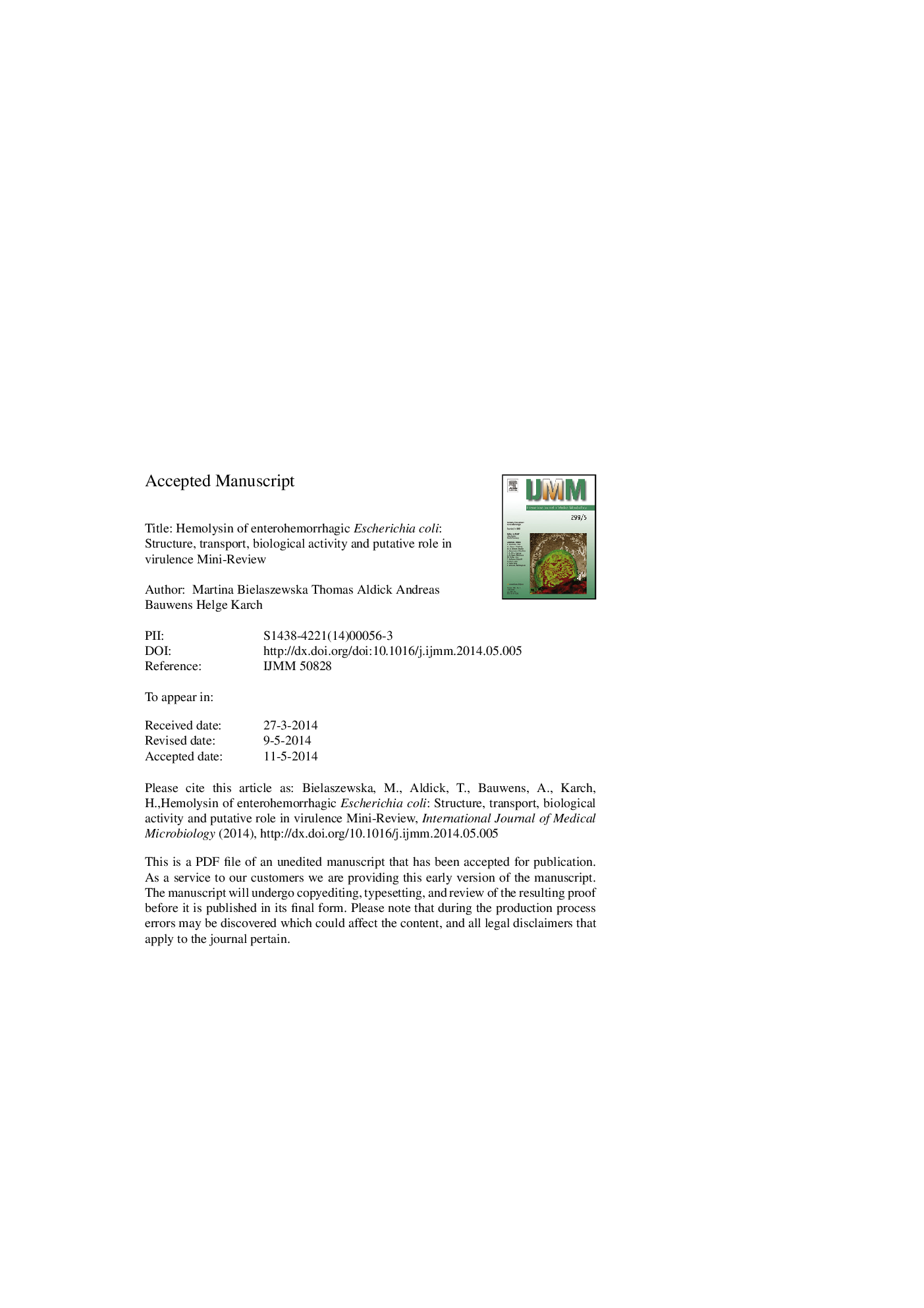| کد مقاله | کد نشریه | سال انتشار | مقاله انگلیسی | نسخه تمام متن |
|---|---|---|---|---|
| 8385512 | 1543694 | 2014 | 32 صفحه PDF | دانلود رایگان |
عنوان انگلیسی مقاله ISI
Hemolysin of enterohemorrhagic Escherichia coli: Structure, transport, biological activity and putative role in virulence
دانلود مقاله + سفارش ترجمه
دانلود مقاله ISI انگلیسی
رایگان برای ایرانیان
کلمات کلیدی
موضوعات مرتبط
علوم زیستی و بیوفناوری
بیوشیمی، ژنتیک و زیست شناسی مولکولی
بیوشیمی، ژنتیک و زیست شناسی مولکولی (عمومی)
پیش نمایش صفحه اول مقاله

چکیده انگلیسی
Enterohemorrhagic Escherichia coli (EHEC) cause diarrhea, bloody diarrhea and hemolytic-uremic syndrome (HUS), a thrombotic microangiopathy affecting the renal glomeruli, the intestine, and the brain. The pathogenesis of EHEC-mediated diseases is incompletely understood. In addition to Shiga toxins, the major virulence factors of EHEC, the contribution of EHEC hemolysin (EHEC-Hly), also designated EHEC toxin (Ehx), which is a member of the RTX (repeats-in-toxin) family, is increasingly recognized. The toxin and its activation and secretion machinery are encoded by the EHEC-hlyCABD operon, in which EHEC-hlyA is the structural gene for EHEC-Hly and the EHEC-hlyC product mediates post-translational activation of EHEC-Hly; the EHEC-hlyB- and EHEC-hlyD-encoded proteins form, together with genetically unlinked TolC, the type I secretion system that transports EHEC-Hly out of the bacterial cell. EHEC-Hly exists in two biologically active forms: as a free EHEC-Hly, and an EHEC-Hly associated with outer membrane vesicles (OMVs) that are released by EHEC during growth. The OMV-associated form results from a rapid binding of free EHEC-Hly to OMVs upon its extracellular secretion. The OMV association stabilizes EHEC-Hly and thus substantially prolongs its hemolytic activity compared to the free toxin. The two EHEC-Hly forms differ by their mechanism of toxicity toward human intestinal epithelial and microvascular endothelial cells, which are the major targets during EHEC infection. The free EHEC-Hly lyses human microvascular endothelial cells, presumably by pore formation in the cell membrane. In contrast, the OMV-associated EHEC-Hly does not lyse any of these cell types, but after its cellular internalization via OMVs it targets mitochondria and triggers caspase-9-mediated apoptosis. The proinflammatory potential of EHEC-Hly, in particular its ability to elicit secretion of interleukin-1β from human monocytes/macrophages, might be an additional mechanism of its putative contribution to the pathogenesis of EHEC-mediated diseases. Increasing understanding of molecular mechanisms underlying interaction of EHEC-Hly with target cells as well as the host cell responses to the toxin supports the involvement of EHEC-Hly in the pathogenesis of EHEC-mediated diseases and forms a basis for prevention of the EHEC-Hly-mediated injury during human infection.
ناشر
Database: Elsevier - ScienceDirect (ساینس دایرکت)
Journal: International Journal of Medical Microbiology - Volume 304, Issues 5â6, July 2014, Pages 521-529
Journal: International Journal of Medical Microbiology - Volume 304, Issues 5â6, July 2014, Pages 521-529
نویسندگان
Martina Bielaszewska, Thomas Aldick, Andreas Bauwens, Helge Karch,